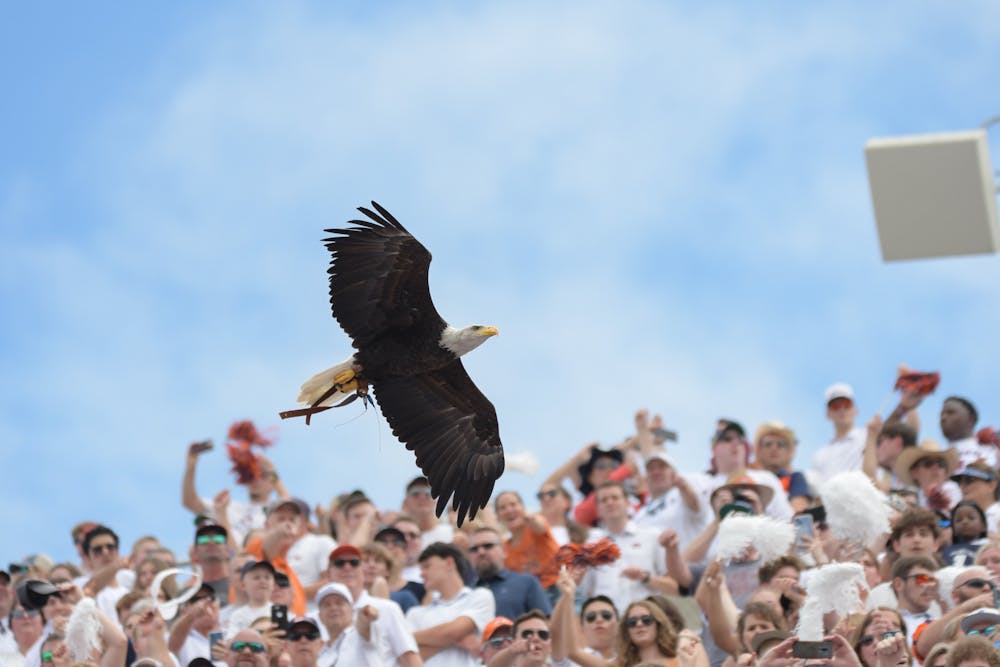On Auburn University's game days, an eagle can be seen soaring above the Jordan-Hare stadium, spurred on by Auburn’s famous battle cry, “War Eagle.” When the eagle isn’t flying high above crowds of orange and blue, it can be located at the Auburn University Raptor Center with a variety of other raptors—from hawks and falcons, to owls and vultures.
The Auburn University Raptor Center reached its 50th anniversary in 2022, celebrating five decades of raptor rehabilitation, conservation and education.
Wade Stevens, the current director of the center, is previously from Orange Beach, Ala., where he spent most of his career working in public safety. While in public safety, Stevens received calls for anything that went wrong, regardless of whether it was in his jurisdiction or not.
As Stevens answered to wildlife emergencies that were called in, his preexisting interest in nature and conservation grew.
“On the Gulf Coast with the unique habitat and species we have there, and just the diversity of Alabama, it was very frequent that we were getting called to everything from sea turtles to marine mammals and birds,” Stevens said.
Working with the fire service at that time, Stevens took it upon himself to learn more about how to help these animals.
“I started to seek out training at different facilities, went to marine mammal places that existed already in other states, and trained in sea turtle facilities, wildlife rehabilitators that were working with birds, and things of that nature,” Stevens said.
In the latter part of his career, Stevens transferred from the fire service to a division called Coastal Resources, whose primary job was to handle conservation efforts and habitat projects. It is his experience and background that led Stevens to where he is today, serving as the Raptor Center Director.
Although Stevens’ current job looks a bit different than his work on the coast, conservation, rehabilitation and education remain at the heart of what he does.
The Auburn University Raptor Center is a division of the College of Veterinary Medicine. They are united in their mission to provide rehabilitation and veterinary care to orphaned, injured and ill raptors that came from the wild, in addition to resident raptors that are housed for educational purposes.
“We have paid staff, both full time and part-time—that includes everything from temporary to student workers,” Stevens said. “Then we have student volunteers and volunteers at large, which are straight from the public. It takes quite a bit to make it all go round.”
Stevens loves interacting with the staff and volunteers and expressed his appreciation for the hard work they pour into the program. Stevens also enjoys spending time with the raptors themselves.
“It’s so easy to love the birds and develop relationships with them,” Stevens said.
His favorite part of his job is getting to observe the interaction between the public and the raptors at shows or events. Tours, available through appointment, are conducted daily, while pregame flights have been a long-held tradition.
“The first time I went for the purposes of flying a raptor, or free-flying in the stadium, it was a very different experience,” Stevens said. “As the new director there for the first time, releasing a free-flighted raptor into an 80 plus thousand person stadium, there was a lot going on—but it’s probably been my favorite memory so far.”
The two eagles that typically fly pre-game are Aurea and Independence, or Indy for short. The birds’ behavior is assessed by trainers, which then determines which eagle will fly before a game.
“I would say it’s the equivalent of a coach making a decision on a quarterback when he has more than one that’s at starting level,” Stevens said.
The tradition of the War Eagle’s flight around the Jordan-Hare dates back to 1892, when a Civil War Veteran had brought his eagle to the first Auburn and Georgia football game. Suddenly, the eagle broke free and began circling the field amid spectators who began shouting, “War Eagle!”
Currently, the Auburn University Raptor Center has roughly 21 resident raptors. Aside from flying at Auburn football games, the center’s raptors have flown for the Philadelphia Eagles and Indianapolis Colts.
Although Auburn University’s Raptor Center provides these services, they do not presently receive funding from athletics or the trademark of “War Eagle,” which is on products everywhere. Instead, they have a very small budget to continue their important programs—made possible by donations and the purchasing of raptor show tickets.
“I just really encourage people to understand where it is we derive our support and funding from,” Stevens said. “We’re there for the fans, we’re there for the people who want to learn more about conservation and raptors in general.”
Stevens and Auburn University’s Raptor Center are fiercely dedicated to conservation and rehabilitation and encourage people to schedule a tour, as support for the Raptor Center keeps the tradition of the “War Eagle” alive and in beak condition.
Do you like this story? The Plainsman doesn't accept money from tuition or student fees, and we don't charge a subscription fee. But you can donate to support The Plainsman.
Ella Walton, majoring in English literature with a minor in creative writing, currently serves as the Newsletter Editor at The Auburn Plainsman. Formerly the Culture Editor, Walton has been with The Auburn Plainsman since the fall of 2023.






